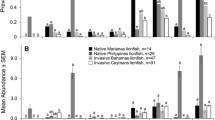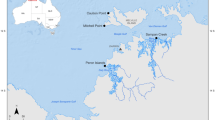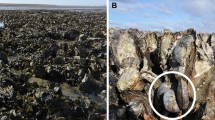Abstract
An understanding of host–parasite interactions represents an important, but often overlooked, axis for predicting how polar marine biodiversity may be impacted by continued environmental change over the next century. Here, we survey three species of crocodile icefish (Notothenioidei: Channichthyidae) collected from two island archipelagos in the southern Scotia Arc region for evidence of leech infestations. Specifically, we report on infestation prevalence, intensity, spatial patterns of relative abundances, size distribution of parasitized fish, and patterns of host and attachment site specificity. Our results reveal high levels of attachment area fidelity for each leech species. These results suggest skin thickness and density of the vascular network constrain leech attachment sites and further suggest trophic (i.e., post-cyclic) transmission to be an important axis of parasitization. We also demonstrate that, while leech species appear to be clustered spatially, this clustering does not appear to be correlated with fish biomass. This study illuminates the complex interactions among fish hosts and leech parasites in the Southern Ocean and lays the groundwork for future studies of Antarctic marine leech ecology that can aid in forecasting how host–parasite interactions may shift in the face of ongoing climate change.




Similar content being viewed by others
References
Adamson ML, Caira JN (1994) Evolutionary factors influencing the nature of parasite specificity. Parasitology 109(Suppl):S85–S95
Adler D (2005) Vioplot: Violin plot. R package
Arana PM, Jones CD, Alegría NA, Sarralde R, Rolleri R (2020) Antarctic demersal finfish around the Elephant and the South Orkney islands: distribution, abundance and biological characteristics. Lat. Am. J Aquat. Res 48
Arlettaz R (1999) Habitat selection as a major resource partitioning mechanism between the two sympatric sibling bat species Myotis myotis and Myotis blythii. J Anim Ecol 68:460–471
Bashey F (2015) Within-host competitive interactions as a mechanism for the maintenance of parasite diversity. Philos Trans R Soc Lond B Biol Sci. https://doi.org/10.1098/rstb.2014.0301
Bielecki A, Rokicka M, Ropelewska E, Dziekońska-Rynko J (2008) Leeches (Hirudinida: Piscicolidae)-parasites of Antarctic fish from Channichthyidae family. Wiad Parazytol 54:345–348
Brinkmann A Jr (1948) Some new and remarkable leeches from the Antarctic seas. Sci Results I Kommisjon Hos Jacob Kybwad Oslo Norw Antarct Exped 1927–1928(29):1–20
Brown SP, Renaud F, Guégan JF, Thomas F (2001) Evolution of trophic transmission in parasites: the need to reach a mating place? J Evol Biol 14:815–820
Bush AO, Lafferty KD, Lotz JM, Shostak W (1997) Parasitology meets ecology on its own terms: Margolis et al. revisited. J Parasitol 83:575–583
Choisy M, Brown SP, Lafferty KD, Thomas F (2003) Evolution of trophic transmission in parasites: why add intermediate hosts? Am Nat 162:172–181
Cocca E, Ratnayake-Lecamwasam M, Parker SK et al (1995) Genomic remnants of alpha-globin genes in the hemoglobinless antarctic icefishes. Proc Natl Acad Sci USA 92:1817–1821
Collins MA, Brickle P, Brown J, Belchier M (2010) The Patagonian toothfish: biology, ecology and fishery. Adv Mar Biol 58:227–300
Cruz-Lacierda ER, Toledo JD, Tan-Fermin JD, Burreson EM (2000) Marine leech (Zeylanicobdella arugamensis) infestation in cultured orange-spotted grouper, Epinephelus coioides. Aquaculture 185:191–196
De la Mare WK (1994) Estimating confidence intervals for fish stock abundance estimates from trawl surveys. CCAMLR Sci 1:203–207
Delord K, Gasco N, Barbraud C, Weimerskirch H (2009) Multivariate effects on seabird bycatch in the legal Patagonian toothfish longline fishery around Crozet and Kerguelen Islands. Polar Biol 33:367–378
Dornburg A, Lamb AD, Warren D et al (2019) Are geckos paratenic hosts for Caribbean Island Acanthocephalans? Evidence from Gonatodes antillensis and a global review of squamate reptiles acting as transport hosts. Bull Peabody Mus Nat His 60:55–79
Duhamel G, Ozouf-Costaz C, Cattaneo-Berrebi G, Berrebi P (1995) Interpopulation relationships in two species of Antarctic fish Notothenia rossii and Champsocephalus gunnari from the Kerguelen Islands: an allozyme study. Antarct Sci. https://doi.org/10.1017/s0954102095000496
Eastman JT (2000) Antarctic notothenioid fishes as subjects for research in evolutionary biology. Antarct Sci. https://doi.org/10.1017/s0954102000000341
Eastman JT, Hikida RS (1991) Skin structure and vascularization in the Antarctic notothenioid fish Gymnodraco acuticeps. J Morphol 208:347–365
Egginton S, Rankin JC (1998) Vascular adaptations for a low pressure/high flow blood supply to locomotory muscles of Antarctic icefish. In: Fishes of Antarctica. Springer, Milano, pp 185–195
Everson I (2015) Designation and management of large-scale MPAs drawing on the experiences of CCAMLR. Fish Fish 18:145–159
Everson I, Parkes G, Kock K-H, Boyd IL (1999) Variation in standing stock of the mackerel icefish Champsocephalus gunnari at South Georgia. J Appl Ecol 36:591–603
Flores HK, Kock K-H, Wilhelms S, Jones CD (2004) Diet of two icefish species from the Southern Shetland Islands and Elephant Island, Champsocepalus gunnari and Chaenocephalus aceratus. Polar Biol 27:119–129
Fuselier L, Edds D (1994) Habitat Partitioning among Three Sympatric Species of Map Turtles, Genus Graptemys. J Herpetol 28:154
Gehman A-LM, Hall RJ, Byers JE (2018) Host and parasite thermal ecology jointly determine the effect of climate warming on epidemic dynamics. Proc Natl Acad Sci USA 115:744–749
Giraldo C, Boutoute M, Mayzaud P et al (2016) Lipid dynamics in early life stages of the icefish Chionodraco hamatus in the Dumont d’Urville Sea (East Antarctica). Polar Biol 40:313–320
Gutt J, Cummings V, Dayton P, et al (2015) Antarctic marine animal forests: three-dimensional communities in Southern Ocean ecosystems. In: Marine animal forests, pp 1–30
Hintze JL, Nelson RD (1998) Violin plots: a box plot-density trace synergism. Am Stat 52:181
Holmes JC (1961) Effects of concurrent infections on Hymenolepis diminuta (Cestoda) and Moniliformis dubius (Acanthocephala). I. General effects and comparison with crowding. J Parasitol 47:209–216
Humphries NE, Simpson SJ, Wearmouth VJ, Sims DW (2016) Two’s company, three’s a crowd: fine-scale habitat partitioning by depth among sympatric species of marine mesopredator. Mar Ecol Prog Ser 561:173–187
Iglesias-Piñeiro J, González-Warleta M, Castro-Hermida JA et al (2016) Transmission of Calicophoron daubneyi and Fasciola hepatica in Galicia (Spain): temporal follow-up in the intermediate and definitive hosts. Parasit Vectors. https://doi.org/10.1186/s13071-016-1892-8
Jones C (2000) Revised estimates of seabed areas within the 500 M isobath of the South Orkney Islands (Subarea 48.2) and consequences for standing stock biomass estimates of nine species of finfish. CCAMLR Sci 7:197–204
Jones C, Sexton SN, Cosgrove RE III (1999) Surface areas of seabed within the 500 m isobath for regions within the South Shetland Islands (SUBAREA 48.1). CCAMLR Sci 6:133–140
Karlsbakk E (2004) A trypanosome of Atlantic cod, Gadus morhua L., transmitted by the marine leech Calliobdella nodulifera (Malm, 1863) (Piscicolidae). Parasitol Res 93:155–158
Kennicutt MC, Chown SL, Cassano JJ et al (2015) A roadmap for Antarctic and Southern Ocean science for the next two decades and beyond. Antarct Sci 27:3–18
Kennedy CR (1999) Post-cyclic transmission in Pomphorhynchus laevis (Acanthocephala). Folia Parasitol 46:111–116
Khan RA (1980) The leech as a vector of a fish piroplasm. Can J Zool 58:1631–1637
Khan RA (1984) Simultaneous transmission of a piscine piroplasm and trypanosome by a marine leech. J Wildl Dis 20:339–341
Kmentová N, Mašová Š, Jirounková E, Nezhybová V, Vanhove, MP (2016) Leeches of notothenioid fishes in Antarctica: new species discovery and phylogenetic position. In: Proceedings from the 5th workshop of the European Centre of IchthyoParasitology, 28–30 November 2016, Prušánky, Czech Republic
Kock K-H (1992) Antarctic fish and fisheries. Cambridge University Press, Cambridge
Kock K-H (2005) Antarctic icefishes (Channichthyidae): a unique family of fishes. A review, Part I. Polar Biol 28:862–895
Kock K-H (2007) Antarctic marine living resources—exploitation and its management in the Southern Ocean. Antarct Sci 19:231
Kock K-H, Everson I (1997) Biology and ecology of mackerel icefish, Champsocephalus gunnari: An Antarctic fish lacking hemoglobin. Comp Biochem Physiol A Physiol 118:1067–1077
Krüger L, Ramos JA, Xavier JC et al (2017) Projected distributions of Southern Ocean albatrosses, petrels and fisheries as a consequence of climatic change. Ecography 41:195–208
Kuhn T, Zizka VMA, Münster J et al (2018) Lighten up the dark: metazoan parasites as indicators for the ecology of Antarctic crocodile icefish (Channichthyidae) from the north-west Antarctic Peninsula. PeerJ 6:e4638
Marancik DP, Dove AD, Camus AC (2012) Experimental infection of yellow stingrays Urobatis jamaicensis with the marine leech Branchellion torpedinis. Dis Aquat Organ 101:51–60
May RM (1978) Host-parasitoid systems in patchy environments: a phenomenological model. J Anim Ecol 47:833
Melillo D, Varriale S, Giacomelli S et al (2015) Evolution of the complement system C3 gene in Antarctic teleosts. Mol Immunol 66:299–309
Muñoz G, Cortés Y (2009) Parasite communities of a fish assemblage from the intertidal rocky zone of central Chile: similarity and host specificity between temporal and resident fish. Parasitology 136:1291–1303
Near TJ, Dornburg A, Kuhn KL et al (2012) Ancient climate change, antifreeze, and the evolutionary diversification of Antarctic fishes. Proc Natl Acad Sci USA 109:3434–3439
Oguz MC, Heckmann RA, Cheng CC et al (2012) Ecto and endoparasites of some fishes from the Antarctic region. Sci Parasitol 13:119–128
Pacala SW, Hassell MP, May RM (1990) Host–parasitoid associations in patchy environments. Nature 344:150–153
Palm HW (2011) Fish parasites as biological indicators in a changing world: can we monitor environmental impact and climate change? In: Progress in parasitology, pp 223–250
Pennington M (1985) Estimating the relative abundance of fish from a series of trawl surveys. Biometrics 41:197
Phillips AJ, Arauco-Brown R, Oceguera-Figueroa A, Gomez GP, Beltrán M, Lai YT, Siddall ME (2010) Tyrannobdella rex n. gen. n. sp. and the evolutionary origins of mucosal leech infestations. PLoS ONE 5:e10057
Pough FH (1971) Leech-repellent property of eastern red-spotted newts, Notophthalmus viridescens. Science 174:1144–1146
Poulin R (1992) Determinants of host-specificity in parasites of freshwater fishes. Int J Parasitol 22:753–758
Poulin R (2001) Interactions between species and the structure of helminth communities. Parasitology 122(S1):S3–S11
Ramasamy P, Ramalingam K, Hanna RE, Halton DW (1985) Microhabitats of gill parasites (Monogenea and Copepoda) of teleosts (Scomberoides spp.). Int J Parasitol 15:385–397
Rauque CA, Semenas LG, Viozzi GP (2002) Post-cyclic transmission in Acanthocephalus tumescens (Acanthocephala: Echinorhynchidae). Folia Parasitol 49:127–130
Raymond B, Lea M-A, Patterson T et al (2014) Important marine habitat off east Antarctica revealed by two decades of multi-species predator tracking. Ecography 38:121–129
Reid WDK, Clarke S, Collins MA, Belchier M (2007) Distribution and ecology of Chaenocephalus aceratus (Channichthyidae) around South Georgia and Shag Rocks (Southern Ocean). Polar Biol 30:1523–1533
Richardson DJ, Abdo A (2011) Postcyclic Transmission of Leptorhynchoides thecatus and Neoechinorhynchus cylindratus (Acanthocephala) to Largemouth Bass (Micropterus salmoides). Comp Parasitol 78:233–235
Ruud JT (1954) Vertebrates without erythrocytes and blood pigment. Nature 173:848–850
Santoro M, Mattiucci S, Cipriani P et al (2014) Parasite communities of icefish (Chionodraco hamatus) in the Ross Sea (Antarctica): influence of the host sex on the helminth infracommunity structure. PLoS ONE 9:e88876
Sawyer RT, Hammond DL (1973) Observations on the marine leech Calliobdella carolinensis (Hirudinea: Piscicolidae), epizootic on the Atlantic menhaden. Biol Bull 145:373–388
Siddall ME, Desser SS (1993) Cytopathological changes induced by Haemogregarina myoxocephali in its fish host and leech vector. J Parasitol 79:297–301
Sidell BD, O’Brien KM (2006) When bad things happen to good fish: the loss of hemoglobin and myoglobin expression in Antarctic icefishes. J Exp Biol 209:1791–1802
Smith WO Jr, Ainley DG, Cattaneo-Vietti R (2007) Trophic interactions within the Ross Sea continental shelf ecosystem. Philos Trans R Soc Lond B Biol Sci 362:95–111
Takahashi M (1983) Trophic ecology of demersal fish community north of the South Shetland Islands, with notes on the ecological role of krill. Mem Natl Inst Polar Res 23:183–192
Targett TE (1981) Trophic ecology and structure of coastal antarctic fish communities. Mar Ecol Prog Ser 4:243–263
Utevsky A (1993) A new marine leech Nototheniobdella sawyeri gen. et sp. n. from Antarctic seas (Hirudinea: Piscicolidae). Zoosystematica Rossica 2:237–240
Utevsky A (2007) Antarctic piscicolid leeches. Zoologisches Forschungdmuseum Alexander Koenig, Bonn
Whittington ID, Cribb BW, Hamwood TE, Halliday JA (2000) Host-specificity of monogenean (platyhelminth) parasites: a role for anterior adhesive areas? Int J Parasitol 30:305–320
Williams R, Smolenski AJ, White RWG (1994) Mitochondrial DNA variation of Champsocephalus gunnari Lönnberg (Pisces: Channichthyidae) stocks on the Kerguelen Plateau, southern Indian Ocean. Antarct Sci. https://doi.org/10.1017/s0954102094000520
Acknowledgements
We thank the captain and crew of the R/V Cabo de Hornos for their excellent company and assistance during the course of this fieldwork and also thank Deris S.A. for providing the ship to carry out the work at sea, and Mr. Enrique Gutiérrez F., general manager of said company, for his permanent support in materializing these tasks. We would additionally like to thank Dieter Piepenburg, Florian Reyda, Aleksander Bielecki, Mario La Mesa, and two anonymous reviewers for providing helpful comments and suggestions on earlier versions of this manuscript. We are particularly grateful for the hypothesis proposed by one of the anonymous reviewers that skin thickness and vascularization are driving the site attachment patterns we observed.
Author information
Authors and Affiliations
Corresponding author
Ethics declarations
Conflict of interest
The authors declare that they have no competing interests.
Ethical approval
The authors have followed all applicable national and institutional guidelines for the collection, care, and ethical use of research organisms and material in the conduct of the research, in strict accordance with NOAA Antarctic Ecosystem Research Division policies under ACA Permit #2017-012. Animal collection was approved by the Yale University Institutional Animal Care and Use Committee (Protocol 10681) and adheres to the AFS guidelines for Use of Fishes in Research (https://fisheries.org/docs/wp/Guidelines-for-Use-of-Fishes.pdf).
Additional information
Publisher's Note
Springer Nature remains neutral with regard to jurisdictional claims in published maps and institutional affiliations.
Electronic supplementary material
Below is the link to the electronic supplementary material.
Rights and permissions
About this article
Cite this article
Parker, E., Jones, C.D., Arana, P.M. et al. Infestation dynamics between parasitic Antarctic fish leeches (Piscicolidae) and their crocodile icefish hosts (Channichthyidae). Polar Biol 43, 665–677 (2020). https://doi.org/10.1007/s00300-020-02670-x
Received:
Revised:
Accepted:
Published:
Issue Date:
DOI: https://doi.org/10.1007/s00300-020-02670-x




